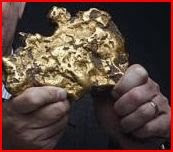 Huge Nugget Sold for $460,000.
Huge Nugget Sold for $460,000.This nugget was found by a man in his own back yard. Wouldn't that be fun? He also found two other smaller nuggets. One of the smaller ones sold for $7000, and the other for $17000 if I remember correctly.
Now that would be some fun homework. Imagine being able to find nuggets like that in your back yard. I'd probably be out there digging all the time. There would be a hole half way to China.
I think I'd finding natural untouched undisturbed gold nuggets would be more fun than anything - maybe because that is one thing I've never really done yet.
Here is the link to the entire story.
http://www.sfgate.com/cgi-bin/article.cgi?f=/c/a/2011/03/16/BARD1ID82A.DTL
It is interesting how one thing leads to another when you are researching history. Every clue leads to something else. Then you have more leads and find more clues. Even factual errors can lead to additional information and step-by-step you end up getting more and more information.
I like doing those posts where I open up a topic and continue to get more information and keep adding to the story a little day after day. I hope you like them as much as I do.
If you are interested in South Florida history and especially the Indian mounds of Florida you might want to check out this thread which I found in a forum about hiking in Florida. It talks about some Indian mounds that are more or less accessible for visitors. This isn't some gone-wild treasure hunter thing. In fact the Palm Beach County Historic Preservation Officer/Archaeologist is a contributor and leads some of the hikes.
Here is the link to that forum.
http://www.myfloridahikes.com/forum/topics/indian-mounds-in-sofla?commentId=2257444%3AComment%3A39439&xg_source=activity
You might occasionally find old license plates, especially if you hunt along some of the local waterways. Did you know that there are people who collect old license plates, and some sell for good amounts. The license plate reading OUTOFTIME that was on the car used in the movie Back to the Future sold for over $10,000.
Kovels Komments says, Pennsylvania began issuing license plates in 1906. Early plates were enamel and were issued to the driver, not the vehicle. The first plates issued for a specific vehicle were made in 1910. A metal tag in the shape of a keystone was attached to each plate. The first plates for dealers were also made in 1910, but without the keystone... Collectors search for plates with low numbers or special number combinations, plates made of unusual materials, those that are smaller than usual or commemorate special events, plates that have unusual pictures or slogans, interesting vanity plates, and special plates that belonged to a famous person or were used in a movie or TV show... There is a club for collectors of license plates, Automobile License Plate Collectors Association, Inc., 118 Quaker Rd., Hampton, VA 23669-2024, website www.alpca.org.
Now I'll give some very basic tips that will help you find more gold if you want to hunt some of the tourist beaches during Spring Break. One of the first and most important things is beach selection.
Here are some factors that you should consider.
Fact 1. Some cultures and groups wear more gold than others. That is obvious, but take advantage of that knowledge and hunt beaches where the people who wear more gold gather.
Fact 2. Wealthier and flashier people tend to wear better jewelry than poorer and less ostentatious people. That is not always true because some wealthy people do not wear much good gold while there are some poorer groups that do wear good gold. If you watch a TV show about India for example, you will see some very poor people wearing a lot of high-karat gold.
Given the choice between hunting a beach with a lot of low-quality jewelry versus one with higher quality jewelry, I would often take the beach with the higher quality stuff even if the finds are less frequent. Some beaches have a lot of gold but some of those beaches will have predominantly lower-quality 10K or plated gold or silver rather than 14K or 18k gold, for example. And some cultures still use 20K gold.
Fact 3. Tourists tend to lose more gold than locals. First, tourists often do not want to leave their valuables in the car or hotel and so unlike locals are more likely to wear their good stuff to the beach. Second, tourists often are not aware of how easily gold can be lost in the sand or water.
Fact 4. Young active people usually lose more jewelry than more mature people. It is often the diving, hand-stands, cart-wheels and other youthful carelessness that leads to many of the loses.
Summary Conclusion. Not taking beach or water conditions or other factors into account, you will find more gold where young active wealthy careless people, tourists and people from gold wearing cultures gather, style and frolic. South Florida has beaches where all of those factors come together to create some great hunting.
I have created and use my own checklist of over twenty factors that can be used to select the most productive jewelry beaches. The above are only four of the main factors taken from the socio-economic factors section of my checklist.
Conditions and Forecast.
On the Treasure Coast the wind is now from the northeast and the seas are running only about two feet. WE had a big low tide yesterday afternoon and will have one this afternoon after a nice high tide. That should move some material around.
Six foot seas are predicted for tomorrow. That is a pleasant surprise. Between the Super Moon, the northeast winds and the increased swells, it might get a little more interesting.
Happy hunting,
TreasureGuide@comcast.net